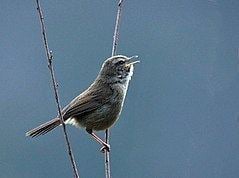Superorder Neoaves Infraorder Passerida Phylum Chordata Order Passerine | Infraclass Neognathae Suborder Passeri Rank Genus Subclass Modern birds | |
 | ||
Lower classifications Japanese bush warbler, Manchurian bush warbler, Brown‑flanked bush warbler, Aberrant bush warbler, Sunda bush warbler | ||
01 japanese bush warbler 01 song horornis diphone
Horornis is a genus of small insectivorous songbirds ("warblers") which make up the core of the newly recognized family Cettiidae. They were formerly placed in the Sylviidae, which at that time was a wastebin taxon for the warbler-like Sylvioidea. The range of this genus occurs from southeast Asia throughout the western Pacific. The most recently described species is the Bougainville bush warbler (Horornis haddeni) from Bougainville Island.
Contents
These typical bush warblers share the lifestyle and related adaptations and apomorphies with Bradypterus, the other genus called bush warblers. However, Bradypterus is related to the grass warblers of Locustella and Megalurus and is more distant from Cettia. Both "bush warbler" genera are smallish birds well adapted to climbing among shrubbery. They are markedly long-tailed birds, at first glance somewhat reminiscent of wrens.
These are quite terrestrial birds, which live in densely vegetated habitats such as thick forest and reedbeds. They will walk away from disturbance rather than flush. The plumage similarities and skulking lifestyle makes these birds hard to see and identify.
These bush warblers tend towards rich or greyish browns above and buffish or light grey tones below. They have little patterning apart from the ubiquitous supercilium. Altogether, they appear much like the plainer species among Acrocephalus marsh warblers in coloration. Megalurid bush warblers tend to be somewhat slimmer and have a very long and pointed tail, but are otherwise very similar.
Species
This genus has been split from the genus Cettia. Cetti's warbler (C. cetti), the previous type species, seems close to the genus Tesia from Southeast Asia and neighboring regions. Birds in the genus Horornis, such as the famous uguisu (鶯, Japanese bush warbler, H. diphone) and the brown-flanked bush warbler (H. fortipes) belong to a group that might include the aberrant broad-billed warbler (Tickellia hodgsoni). This latter species differs wildly in its gaudy colors but in habitus is a typical "bush warbler".
